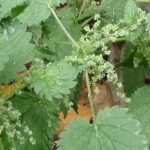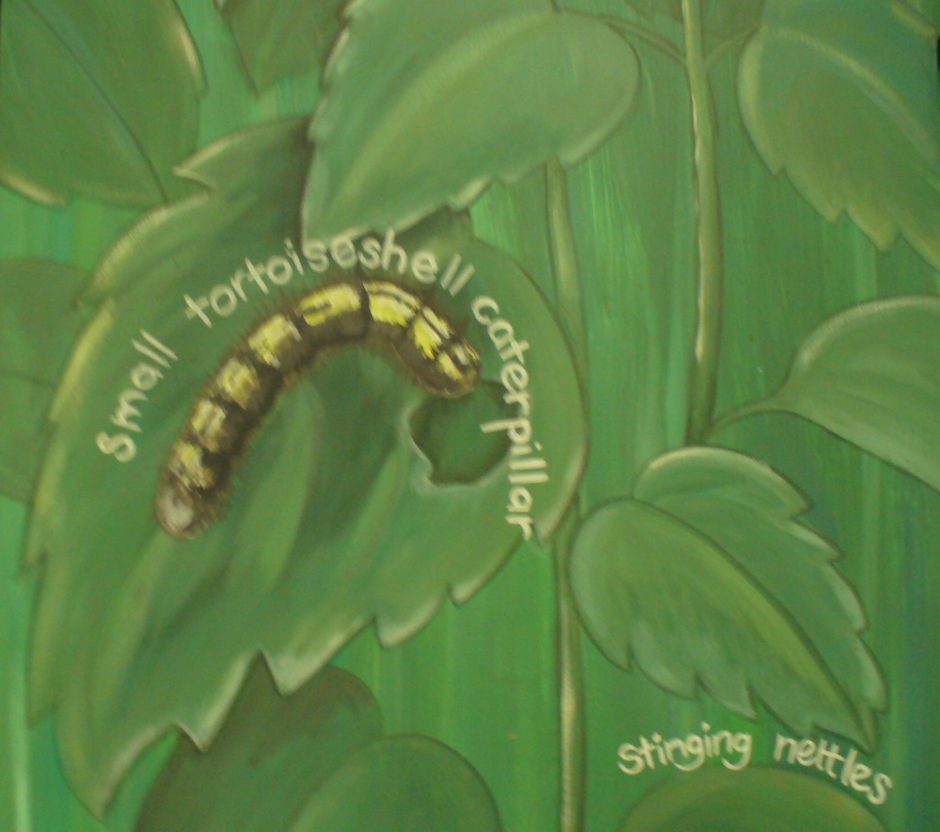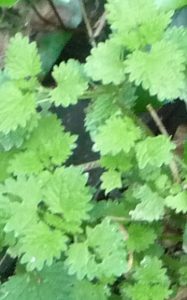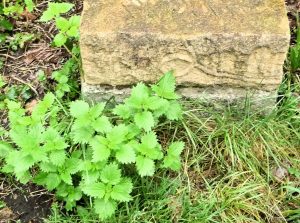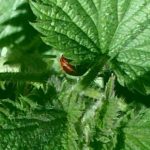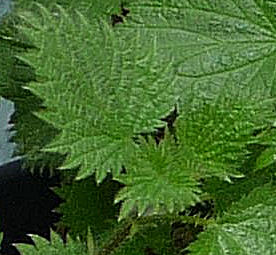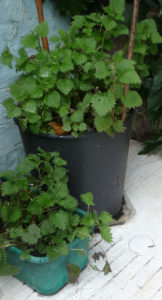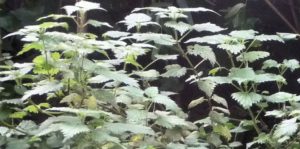STINGING NETTLE – Urtica dioica
Europe, Asia, North Africa & Western North America
Urtica dioica is a familiar perennial. This ‘noxious weed’ prefers fertile, nitrogen-rich soil & is often found close to human habitation. Growing by stolons & a strong underground root system, Stinging Nettle’s rigid stems can reach one metre in height. Its deep green leaves are oval, with toothed edges & pointy tips. The plant’s flowers – light green catkins – appear between June and September.
You may walk past any number of leafy green plants & find that you only notice the Stinging Nettle. The fine hollow hairs that cover its leaves & stems act as hypodermic needles, delivering a chemical cocktail to any part of your body that touches the plant. The injured body part will react with an itching, stinging pain that can last for hours.
Good for Wildlife
Stinging Nettle is relied on as a larval food plant by British Butterflies: Comma, Painted Lady, Peacock, Red Admiral & Small Tortoiseshell.
Britain’s butterfly & moth populations are under threat. If you want to help them survive, you might consider keeping a patch of Stinging Nettle. Little care is required. You need do nothing once the plant is given a corner of the garden to itself. It will carry on.
Moths who rely on the plant : Angle Shades, Bordered Pearl, Buff Ermine, Burnished Brass, Dot Moth, Dotted Clay, Flame, Garden Tiger, Ghost Moth, The Gothic, Grey Chi, Grey Pug, Lesser Yellow Underwing, Mother of Pearl, Mouse Moth, Mottled Rustic, Silver Y, Small Angle Shades, Small Magpie & White Ermine.
Fly Deterrent Although upwards of thirty insects feed solely on the Nettle in Britain, our flies have a distaste for the plant. A fresh bunch of Stinging Nettles will keep a larder free from them.
http://www.botanical.com/botanical/mgmh/n/nettle03.html
Stinging Nettles as a Source of Food
Eaten by people of many countries, Stinging Nettles are known as ‘poor man’s spinach’. They are seen as edible – even tasty – when cooked, once the stingers have been dealt with. Eating them raw is not recommended.
“Stinging nettles are very nutritious. They have high levels of Vitamin A and Vitamin C. Young leaves should be picked between late February and early June, using scissors and gloves for comfort. Gather only the youngest leaves from the top of each plant… The very best nettles are the whole shoots picked when they are just a few centimetres high in March.”
Recipes: Nettle Puree, Nettle Soup, Nettle Haggis
Richard Mabey, FOOD FOR FREE, Collins, 1972
Edible Wild Food, a website from Ontario, Canada, covers foraging, fungi & weeds. Recipes: Leek & Nettle Soup, Nettle Mustard Pesto, Nettle Pesto, Stinging Nettle Beer, Stinging Nettle Hummus, Stinging Nettle Soup
http://www.ediblewildfood.com/stinging-nettle.aspx
wildfoodshomegarden.com This ‘practical guide using organic gardening methods’ from North America has advice on how to grow & harvest Stinging Nettles. The author, David G. Mills, goes into serious detail about how the taste of the nettles is influenced by the location in which they are grown.
http://wildfoodshomegarden.com/StingingNettle.html
Herbal and Medicinal
 ” Nettle is a wonderful plant and has been used for hundreds of years. It is highly nutritious, containing silicon, protein, potassium, chlorophyll and vitamins A and C. It is a great tonic for the whole body, especially for anaemic people or those recovering from illness. Due to its astringent properties, nettle is traditionally used to treat diarrhoea, dysentery and abnormal discharges and it is invaluable in chronic diseases of the colon. “
” Nettle is a wonderful plant and has been used for hundreds of years. It is highly nutritious, containing silicon, protein, potassium, chlorophyll and vitamins A and C. It is a great tonic for the whole body, especially for anaemic people or those recovering from illness. Due to its astringent properties, nettle is traditionally used to treat diarrhoea, dysentery and abnormal discharges and it is invaluable in chronic diseases of the colon. “
http://happyherbcompany.com/nettle
Magical
‘Nettles have of old had an association with lightning, and with serpents. Legends say that the Great Serpent Lightning gave the plant some of his sting, while others speak of the Underworld Serpent giving the plant some of his poison. The Romany gypsies have folklore that states that the nettle grows in places where there are underground passages to places where Earth faeries, or Pcuvus, dwell � the nettles are dedicated to these beings.’
Ali English, Eldrum Herbs, https://www.eldrumherbs.co.uk/content/content_files/profiles_nettle_urtica-dioica.php?state=1
Traditional
Despite the sting, nettles were seen in folklore as protective plants.
In the Austrian region of Tyrol, where nettle weaving continued up until 1917, local superstitions said that throwing nettles on the fire during thunderstorms prevented danger, probably a link to the tradition that nettles were sacred to thunder gods, such as Thor.
http://www.blissfulbees.com/the-wildflowers
“Gin ye be for lang kail coo the nettle, stoo the nettle
Gin ye be for lang kail coo the nettle early
Coo it laich, coo it sune, coo it in the month o’ June
Stoo it ere it’s in the bloom, coo the nettle early
Coo it by the auld wa’s, coo it where the sun ne’er fa’s
Stoo it when the day daws, coo the nettle early.”
Bridget & Maureen Boland, Old Wives Lore for Gardeners
Coo, cow, & stoo are all Scottish for cut back or crop (although another meaning of “stoo” is to throb or ache), while “laich” means short or low to the ground. Given the repetition of “early,” this must be advice to harvest nettles first thing in the morning & to cut them back hard [which seems to contradict the advice of the RHS]. Wikipedia
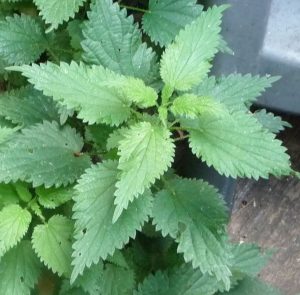
The Danish believe that there are elves buried wherever nettles grow.
Legend has it that Milarepa, a Tibetan saint and ascetic with green hair and skin, managed to survive decades of meditation by feeding off nettles alone.
In Scandinavian mythology Thor, the God of Thunder, is often represented by nettles and this is why they are burned in the fireplace during storms. From the same mythology Loki, the trickster God, wove fishnets from nettles. Nettles Facts and Figures: 26 things to know about nettles, Monica Rossi, Journalist, Mozilla Firefox
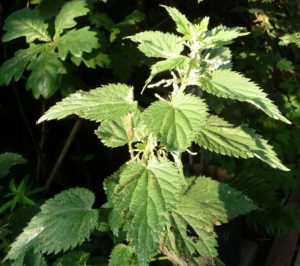 ” In ancient Egypt reports are found of the use of nettle infusion for the relief of arthritis and lumbago pains. A standard practice of flogging oneself with the fresh nettle plant, called urtification, was prescribed to treat such illnesses as chronic rheumatism, lethargy, coma, paralysis, and even typhus and cholera. This practice of urtification is known to many cultures and has been used for thousands of years.
” In ancient Egypt reports are found of the use of nettle infusion for the relief of arthritis and lumbago pains. A standard practice of flogging oneself with the fresh nettle plant, called urtification, was prescribed to treat such illnesses as chronic rheumatism, lethargy, coma, paralysis, and even typhus and cholera. This practice of urtification is known to many cultures and has been used for thousands of years.
The Roman soldiers are said to have brought their own nettles to the British Isles to treat their tired, painful legs on long marches in the cold and wet climate by urtification, thus stimulating the circulation. Documentation or anecdotal reports of its use in this way have been found among the Ecuador Indians, ancient Romans, and Canadian and American native tribes. “
Dr Christopher’s Herbal Legacy, Kassie Vance http://herballegacy.com/Vance_History.html
‘My dad made nettle beer from young nettles every spring. A basket of nettles, sugar, stick of rhubarb [Rheum], ginger [Zingiber] and yeast. He considered it a spring tonic and we drank it all before it had finished fermenting. It makes my mouth water thinking about it [Bevington, Gloucestershire, November 2013].’
Selected from approximately 200 items in PLANT-LORE ARCHIVE. For other tales of the Stinging Nettle : http://www.plant-lore.com/239/nettle/
Bichu, Burn Hazel, Burn Nettle, Burn Weed, Common Nettle, Devil’s Claw, Devil’s Plaything, Feuille d’Ortie, Graine d’Ortie, Grande Ortie, Great Stinging Nettle, Nettle Worth, Ortie, Ortie Brulante, Ortie des Jardins, Ortie Dioique, Ortie Mechante, Ortiga, Small Nettle, Urticae Herba et Folium, Urticae Radix, Wergula (Anglo-Saxon).
Our Highbury Nettle Bucket
Despite the Stinging Nettle’s antisocial reputation, we keep this important wildflower in the garden for its importance to wildlife. Creatures using it as a source of food are given the chance to complete their life cycle. Even if most of its leaves die back in winter, we maintain the plant itself.
However, we do remove Urtica dioica’s flowers. Only a few nettle plants can be fitted into a small space before a stroll into the garden becomes a world of hurt.
Our Stinging Nettle lives in its own Nettle Bucket. In October 2017, the undersides of the nettle’s leaves were peppered with orange dots – eggs laid by some local winged creature. The nettle leaves provided the first food source for butterfly or moth larva hatching from those eggs.
Eating the raw Stinging Nettle is not advised. In 1986, however, a competition arose in the 16thC Bottle Inn in Marshwood, Dorset which challenged human ability to eat massive quantities of the raw plant…
‘ In the United Kingdom an annual Stinging Nettle Eating Championship draws thousands of people to Dorset, where competitors attempt to eat as much of the raw plant as possible. Competitors are given 60 cm (20 in) stalks of the plant, from which they strip the leaves and eat them. Whoever strips and eats the most stinging nettle leaves in a fixed time is the winner. The competition dates back to 1986, when two neighbouring farmers attempted to settle a dispute about which had the worst infestation of nettles. ‘
(http://wildblessings.com/plants/stinging-nettle/ )
This youtube vid gives you the full flavour of the 2007 contest :
https://www.youtube.com/watch?v=2yHBNn22BM0
William Langley gives a vivid description of the 2009 competition in The Telegraph:
“In a sunny garden in deepest Dorset yesterday 65 people – their faces rigid with pain and disgust – gathered in a quest to be crowned the King of the Stingers. There is no easy route to winning the World Stinging Nettle Eating Championship, held each year in the village of Marshwood near Bridport. It takes skill, it takes endurance … it takes great blistering chunks out of what used to be your taste buds. ”
“They taste totally foul, and everything comes out bright green for a few days afterwards,” shrugged Simon Slee, 48, the reigning world record holder with 76 feet. “Apart from that it’s really not too bad. You need focus and rhythm and some beer to take the taste away.”
‘A potential contender for the award of strangest food competition, The Bottle Inn pub hosts contestants who compete to see who can eat the most raw nettles in a given time. Afterwards there will be entertainment by Morris dancers. The English eccentric? Us? Never.
cawston press summer picks guide / TimeOut London Jun 18-24 2019.
The Bottle Inn Pub has had to close, with its last World Stinging Nettle Eating Championship taking place on 27 July 2019. A venue has since been provided by the local cider farm. The 2024 Championships were hosted by Ryan Strong at The Dorset Nectar Cider Farm in Waytown near Bridport. Challengers came from Europe & the United States as well as the UK.
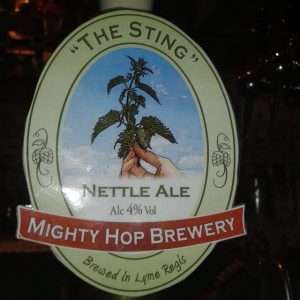
Dorset Nettle Beer: Webpage RATE BEER says that a brew called MIGHTY HOP THE STING (4.0%) was manufactured in Lyme Regis, Dorset, for the World Stinging Nettle Eating Championships.
